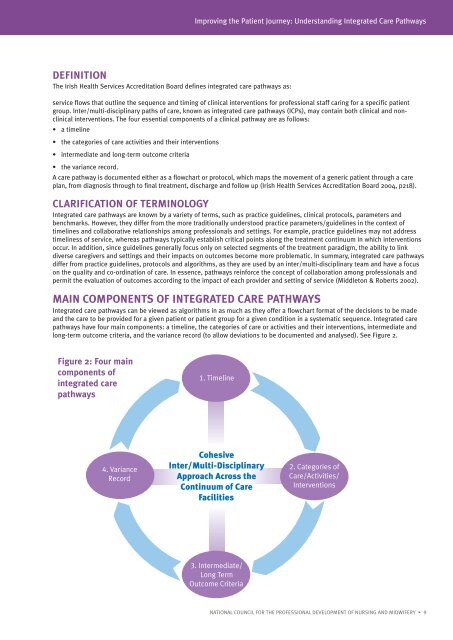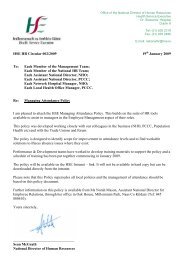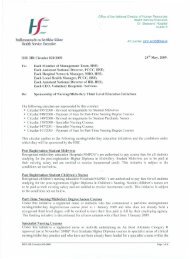Integrated Care Pathways - PNA
Integrated Care Pathways - PNA
Integrated Care Pathways - PNA
- No tags were found...
Create successful ePaper yourself
Turn your PDF publications into a flip-book with our unique Google optimized e-Paper software.
Improving the Patient Journey: Understanding <strong>Integrated</strong> <strong>Care</strong> <strong>Pathways</strong>DEFINITIONThe Irish Health Services Accreditation Board defines integrated care pathways as:service flows that outline the sequence and timing of clinical interventions for professional staff caring for a specific patientgroup. Inter/multi-disciplinary paths of care, known as integrated care pathways (ICPs), may contain both clinical and nonclinicalinterventions. The four essential components of a clinical pathway are as follows:• a timeline• the categories of care activities and their interventions• intermediate and long-term outcome criteria• the variance record.A care pathway is documented either as a flowchart or protocol, which maps the movement of a generic patient through a careplan, from diagnosis through to final treatment, discharge and follow up (Irish Health Services Accreditation Board 2004, p218).CLARIFICATION OF TERMINOLOGY<strong>Integrated</strong> care pathways are known by a variety of terms, such as practice guidelines, clinical protocols, parameters andbenchmarks. However, they differ from the more traditionally understood practice parameters/guidelines in the context oftimelines and collaborative relationships among professionals and settings. For example, practice guidelines may not addresstimeliness of service, whereas pathways typically establish critical points along the treatment continuum in which interventionsoccur. In addition, since guidelines generally focus only on selected segments of the treatment paradigm, the ability to linkdiverse caregivers and settings and their impacts on outcomes become more problematic. In summary, integrated care pathwaysdiffer from practice guidelines, protocols and algorithms, as they are used by an inter/multi-disciplinary team and have a focuson the quality and co-ordination of care. In essence, pathways reinforce the concept of collaboration among professionals andpermit the evaluation of outcomes according to the impact of each provider and setting of service (Middleton & Roberts 2002).MAIN COMPONENTS OF INTEGRATED CARE PATHWAYS<strong>Integrated</strong> care pathways can be viewed as algorithms in as much as they offer a flowchart format of the decisions to be madeand the care to be provided for a given patient or patient group for a given condition in a systematic sequence. <strong>Integrated</strong> carepathways have four main components: a timeline, the categories of care or activities and their interventions, intermediate andlong-term outcome criteria, and the variance record (to allow deviations to be documented and analysed). See Figure 2.Figure 2: Four maincomponents ofintegrated carepathways1. Timeline4. VarianceRecordCohesiveInter/Multi-DisciplinaryApproach Across theContinuum of <strong>Care</strong>Facilities2. Categories of<strong>Care</strong>/Activities/Interventions3. Intermediate/Long TermOutcome CriteriaNATIONAL COUNCIL FOR THE PROFESSIONAL DEVELOPMENT OF NURSING AND MIDWIFERY • 9













